|
|
Post by longshot on Oct 5, 2009 11:41:37 GMT -5
I have just come from the Oglala message board, where I was told that Mitch Bouyer was 1/2 Santee. He is said to have lived with his mother's people when he was a child. That brings me to my question.
In 1865 (about June) he was with a group of about 4 or 5 Whites when he was attacked by a group of Sioux (article said Platte Sioux), but he seemed to know one or more in the tribe as it (The article) said they played together as children. That did little to save him as he was wounded but made it back, while one White was killed. All the rest of the group was either wounded or not but all got away. Is there anyone who can identify this group of Indians, or is there anyone alive who descends from Mitch Bouyer. I believe he had a son and a couple of daughters. This article came from a contemporary edition of the Montana Post.
Thanks
|
|
|
|
Post by jariteilas on Oct 5, 2009 12:10:52 GMT -5
I have just come from the Oglala message board, where I was told that Mitch Bouyer was 1/2 Santee. He is said to have lived with his mother's people when he was a child. That brings me to my question. In 1865 (about June) he was with a group of about 4 or 5 Whites when he was attacked by a group of Sioux (article said Platte Sioux), but he seemed to know one or more in the tribe as it (The article) said they played together as children. That did little to save him as he was wounded but made it back, while one White was killed. All the rest of the group was either wounded or not but all got away. Is there anyone who can identify this group of Indians, or is there anyone alive who descends from Mitch Bouyer. I believe he had a son and a couple of daughters. This article came from a contemporary edition of the Montana Post. Thanks Hi, 1869 Mitch got married with Magpie Outside (crow squaw). They got two children Mary and Thomas.Summer 1870 they moved to live among Mountain Crow -tribe. The tribe adopted Mitch two years later. Little before he died at Little Bighorn he asked his firend Thomas Leforge (Gibbon scout) to take care of his wife and children. Which Leforge did - He got married with the widow and he adopted the children. Regards Jari |
|
Jimmy
New Member
 Margaret Langdeau
Margaret Langdeau
Posts: 14
|
Post by Jimmy on Oct 6, 2009 11:00:04 GMT -5
I'm pretty sure "Platte Sioux" refers to the Sicangu.
|
|
|
|
Post by dandmforever on Sept 22, 2013 17:13:59 GMT -5
My husband's grandmother was Mollie Rosebud Bouyer. Her father was George Bouyer, who was known to be a son of Mitch Bouyer and Magpie Outside. Mollie knew her grandmother, Magpie (Mary), and she knew that her grandfather was Mitch. We can't find any records of George as their son, but we know through the family that he was sent to Alabama by his family as a child and adopted to protect him from extermination. Does anyone have any records of his birth or anything showing his parents as Mitch and Magpie???
|
|
|
|
Post by gregor on May 16, 2014 7:09:44 GMT -5
This is what I have on Mitch Boyer:
Michel “Mitch” Bouyer (sometimes spelled 'Bowyer', 'Buoyer' or ‘Boyer’) was an interpreter and guide in the Old West following the American Civil War.
He was born Michel Bouyer in 1837, his Indian name was Kar-pash. His father, Jean-Baptiste Bouyer (abt. 1810 – 1863), was a French Canadian who was employed by the American Fur Company, trading with Sioux in the Dakota / Wyoming area.
We find Jean-Baptiste Bouyer in an American Fur Co. journal at Fort Tecumseh (later Fort Pierre). This journal reads for December 1, 1830: “ ..[arrival] of Mr. Hay and Baptiste Boyer”. In 1831 we find Baptiste there again in a roster of AFC employees.
On June 13 and 14, 1840 Father Hoecken baptized 36 persons at Fort Pierre. Among these people was “Michel Boyé, 3 years of age”, son of “John” (Jean) Boyé and his sauvagesse (Indian woman)”. He also baptized Michel’s three sisters Marie, Anne and Therese – all three and a half months old! Rare triplets in these days (born 1840). He also had at least two half-brothers: John Bouyer (c. 1845-1871), who was hanged at Fort Laramie for killing an Army scout in the first legal execution in Wyoming Territory, and Antoine Bouyer (born 1852?), whom Walter Mason Camp interviewed in 1912. John, in an interview just before he was hanged, stated that there had been other siblings who had already died.
In the Walter M. Camp interview said Antoine Boyer: “ … Mitch’s father was a full blood Frenchman…. his mother was a full blood Santee Sioux”.
In 1862-63 Jean-Baptiste worked as blacksmith at Fort Laramie and in 1863 he was killed by Indians while trapping. In 1867 Mitch declared the only first-hand biographical data to a judge of Utah. He said to John Fitch Kinney, who investigated the Fetterman Massacre on July 27, 1867: “I am 28 years old [an error, he was born in 1837 not 1839] … I have been …trading with Oglala, Snakes, Bannacks and Crows ….and at Fort C.F. Smith for seven months [since January 1867]. I talk Sioux and Crow”.
Bouyer was an interpreter at Fort Phil Kearny in 1868. In the fall of 1869, he married a young Crow woman named Magpie Outside (or Magpie Out-of-Doors), who became known as Mary. Their first child, also named Mary, was born in 1870. Sometime later they also had a son, apparently named Tom, but eventually called James LeForge. Little before he died at Little Bighorn he asked his close friend Thomas Leforge (Gibbon scout) to take care of his wife and children. After Bouyer's death, his widow Mary was taken in by this friend. When Leforge’s own wife died, he married Mary and adopted her children. This is probably when Mitch's son was renamed, as Leforge had a son of his own named Tom. Mary died in 1916.
Employed by Maj. Eugene Baker, 2nd Cavalry, from August 1 to September 30, 1872, he worked as a guide for the military escort of the Northern Pacific railroad survey in Dakota and Montana Territories. From 1872 on he was employed by the Crow Agency and the US Army.
In 1876 Lt. Col. George Armstrong Custer requested that Bouyer be transferred to the 7th U.S. Cavalry as an interpreter for the Crow scouts when Gen. Alfred Terry ordered the 7th south from the Montana Column to search for hostile Indians. Custer's regular scouts were Ree (Arikara).
At the Crow's Nest, Bouyer was one of the scouts who warned Custer about the size of the Indian village, which Custer claimed he couldn't make out. Bouyer told him, "General, I have been with these Indians for 30 years, and this is the largest village I have ever known of." After failing to convince Custer, it is reported Bouyer gave away his possessions, convinced he would die in the coming battle. The rest is history.
In 1984, a fire burned through much of the Custer Battlefield, enabling archaeological digs to be made. Part of a skull was found that was identified as Bouyer's by comparison of the facial bones with the only photograph known of him. In 1988, a marker for Mitch Bouyer replaced one of the U.S. Soldier markers. Bouyer's step-descendents, the LaForge's, who live in the area, witnessed the unveiling of the marker.
Sources: Internet and “Custer's Last Campaign: Mitch Boyer and the Little Bighorn Reconstructed” by John S. Gray
|
|
|
|
Post by kingsleybray on May 16, 2014 7:38:53 GMT -5
The "Friends of the Little Bighorn" now have a new journal out, the “Ghost Herder”. It´s already on sale in the LBH battlefield bookstore. You can order it online from their website store in July 2011.
www.friendslittlebighorn.com/Little%20Bighorn%20Store.htm
The journal most importantly contains an article by Kingsley M. Bray which deals with letters Eddie Herman of Pine Ridge wrote to Joe Balmer, of Zurich. They contained important new information on the battle of the Little Bighorn, dealing with Lakota accounts bearing on the fates of Lonesome Charley Reynolds and Mitch Bouyer.
Even more interesting to us is the roles of the Oglala/Minicojou warrior Kicking Bear and the Sihasapa woman Mary Crawler in the death of Reynolds and Bouyer.
Read more: amertribes.proboards.com/thread/1262#ixzz31siQW06ngregor, in the article cited here, I present oral traditions collected by Eddie Herman and sent by him to my old mentor Joseph Balmer, which state that Mitch Bouyer was killed by the Sihasapa Lakota warrior woman, Mary Crawler.
|
|
|
|
Post by gregor on May 17, 2014 11:42:12 GMT -5
Kingsley, a big thanks for your recommendation.
|
|
|
|
Post by Dietmar on May 22, 2014 10:38:55 GMT -5
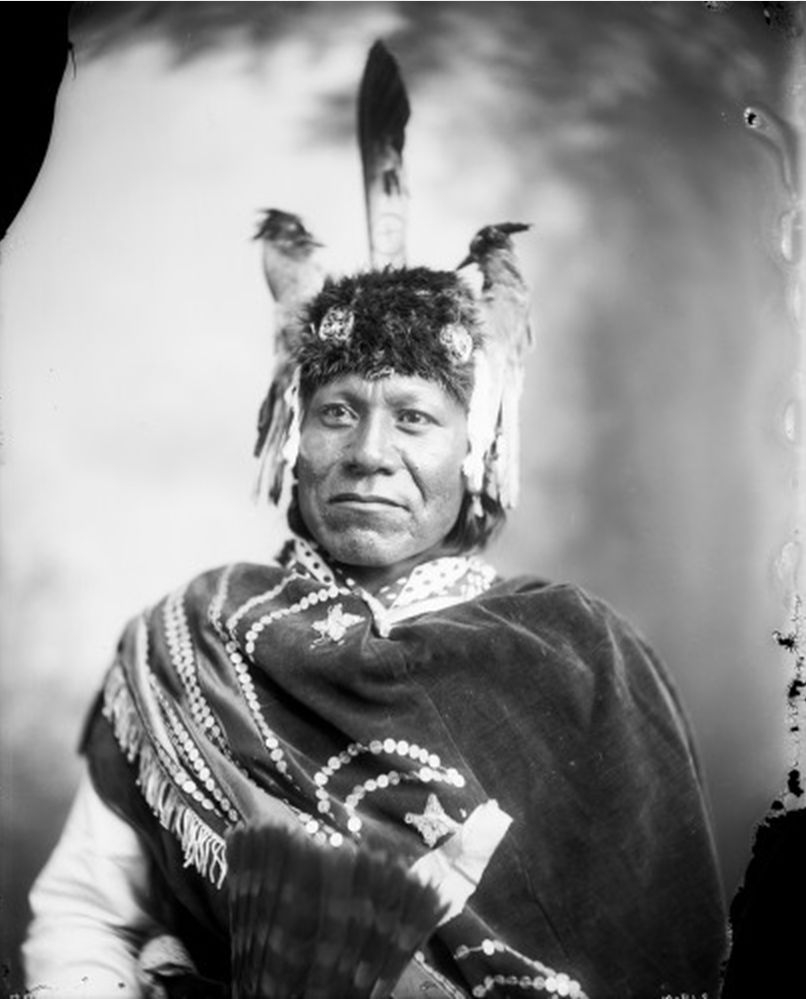 allegedly Mitch Bouyer by D.F. Barry [SIC] |
|
|
|
Post by rawhide on May 24, 2014 1:11:19 GMT -5
Wonderful scan, thank You. Is there any kind of documentation that Barry himself met Bouyer? I was just wondering how far east Bouyer visited after he joined the Crows. It might give us a clue when this was taken, not earlier than '72 I presume. Barry was born 1854. Goff?
|
|
|
|
Post by Dietmar on May 24, 2014 5:47:28 GMT -5
Mmmmh, Bouyer died in 1876. I have that photo among my Barry pics, but Goff seems more likely.
However, the Denver Public Library says the photographer was Charles A. Nast (1856-1931). He was a photographer from Denver, Colorado, and worked as a reporter for the Denver Tribune, and covered the Black Hills Gold Rush. He later established a photo studio in Denver and Central City, Colorado.
|
|
|
|
Post by Dietmar on Sept 21, 2014 4:01:53 GMT -5
I received a message from Koos van Oostrom that the above picture, often allegedly published as a portrait of Mitch Boyer by David. F. Barry is not him. Instead it is an unidentified Ute of the Capote band. The photo is made by Charles A. Nast, a decade or more after Bouyer died.
So we don´t have any authentic portraits of Mitch Boyer, do we?
|
|
|
|
Post by rawhide on Sept 21, 2014 5:51:35 GMT -5
I must say I'm left midair on this one. Personally I took it for granted as John S Gray is such a meticulous researcher that I never even doubted the identification, only the photographer. Well, we might be able to someday trace the origins of all this. Another case of artistic freedom? I guess that the remains found at LBH don't belong to a fallen Ute warrior either  . Hervey Johnson, 11th Ohio Volunteer Cavalry, who was stationed where Mitch was living before he left for Montana, tells in his letters of photographers visiting Ft Laramie late fall 1863 and then in 1864 but Mitch would have looked very very young in those and not a likely candidate for a pose. My guess is that if he was ever photographed it was taken later near the goldfields or Bozeman. WH Jackson had a link with Mitch through Hayden, also. Rawhide |
|
|
|
Post by Dietmar on Apr 28, 2018 17:40:08 GMT -5
Mike Cowdrey has sent me this statement regarding the misidentified "Mitch Bouyer" portrait: I spent two weeks at Denver Public Library in 1990, working through & buying photo copies of hundreds of Indian pictures in their collections---long before the Internet came along, making hard copy storage obsolete. As soon as I saw the full-plate print of the Ute man "A Capore," made in the late-1890s by the Denver photographer Charles A. Nast, I realized that the cropped head, published in the 1950s by W.A. Graham in The Custer Myth, was a hopeful mistake. I immediately asked to see their print identified as "Mitch Bouyer," and showed their late Photo Curator, Augie Mastrogiuseppi, the two photos together, proving that it had been erroneously identified by someone at the Library. The "ID" was written on the back of the original Ute print in pencil, with reference to the page number in The Custer Myth. He said, "Hmmm, that's very interesting...We'll have to look into this." Here's what they did to "fix" their problem (of selling the wrong picture for decades). digital.denverlibrary.org/cdm/singleitem/collection/p15330coll22/id/20646/rec/223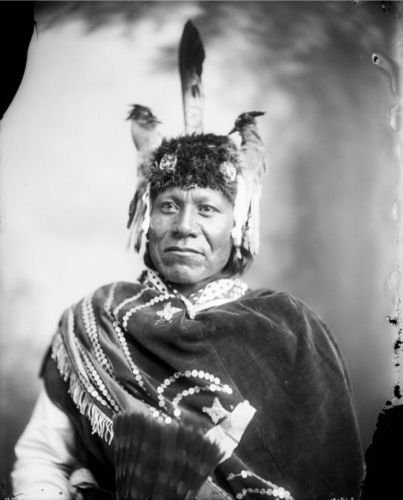 Note that "A Capore" is now gone. And instead of the tight-cropped, scratchy face from Custer Myth, they have a crisp, full-figure image that is MUCH MORE POPULAR. The former negative numbers, "F2728" and "219-N" have been given a NEW number "X-31214", and the identification is now "Mitch Bouyer, Crow." Of course, Bouyer was only married to a Crow woman; he himself was half- Dakota, but most of the potential customers don't know that, and might miss the target if DPL moved the Ute portrait to the Dakota section. Charles A. Nast, who made this portrait, was born in 1856, so was only nineteen or twenty years old when Mitch Bouyer died. Nast first went into the photography business, at 16th & Curtis Sts., Denver, in 1890, fourteen years after Bouyer had been killed. Nor was Bouyer ever IN Denver. Here is PRINTED PROOF that the Nast portrait was NOT identified as "Mitch Bouyer" in ca. 1915. The name "A Capore" is printed in the hand-colored image: www.oldpostcards.com/i/ind400001.html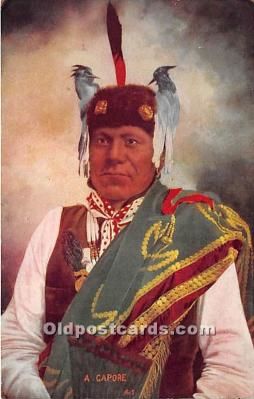 A Capore Indian Postcard The Denver Public Library CONTINUES to sell the "Bouyer" misidentification, to a new generation of LBH buffs. It's hard to stop making money on one of your most-successful mistakes. They will happily sell YOU a print of "Mitch Bouyer," today. An 11" x 14" print, either matte or glossy, is available for only $35.00, plus shipping. Get your order in NOW! When Rich Fox published Archaeology, History & Custer's Last Battle: The Little Big Horn Re-examined, in 1993, featuring his "photo comparison" of the LBH skull fragment overlaid on the Ute photo of "A Capore," PROVING that he had found Bouyer's body, I wrote to him with the above explanation and corrective information. He responded that he had visited with some of Bouyer's descendants, and THEY had the same photo framed in their home, so that was "proof enough" for him (!) Of course, Bouyer's heirs could only have gotten their print in recent years from Denver Public Library, who victimized them, along with everyone else. So, I think that "The Little Big Horn Re-examined" needs to be re-examined. What this illustrates is the long-understood truism that mythology is stronger than truth---a principle being taken to the bank on Capitol Hill, nearly every day in recent months. Nor is this the only example of mistaken images being peddled by Denver Public Library. Apparently at some time in the past, someone contacted the DPL Photo Dept., asking whether they might have a photo of the minor Ute chief Black Whiskers? Unfortunately, they did NOT. But NO PROBLEM: a quick pencil notation on the back of an unidentified print in their collection, and they created another HAPPY CUSTOMER, and a SUCCESSFUL SALE for themselves---a Win-Win situation, all around. Except that the avaricious seller picked a photo of the VERY well-known Crow scout at the Little Bighorn, White Man Runs Him: digital.denverlibrary.org/cdm/singleitem/collection/p15330coll22/id/19383/rec/94 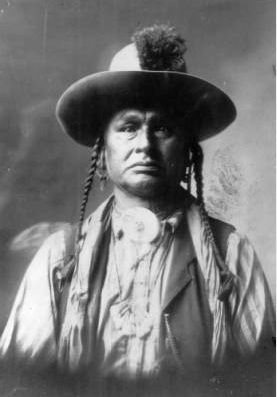 If you have desperately been searching for a photo of your Ute ancestor Black Whiskers, the Denver Public Library is ready to HELP YOU fulfill your dreams. Of course, that also means that the Medicine Crow, and Little Nest, and other families at Crow Agency, who ARE related to White Man Runs Him, are out of luck. But Capitalism can't be expected to help everybody. Mike Cowdrey |
|
|
|
Post by Dietmar on Apr 28, 2018 17:45:18 GMT -5
Note also the earlier made remark of our guest Koos, that the retouched copy of the Nast photo has the heading "A-CAPORE", possibly meaning "a Capote" (Capote: Ute band).
|
|
|
|
Post by Dietmar on Apr 30, 2018 7:43:39 GMT -5
Koos van Oostrom has sent me further proof, that the Nast photo doesn´t show Mitch Bouyer. These pictures are from the collection of the British Museum: 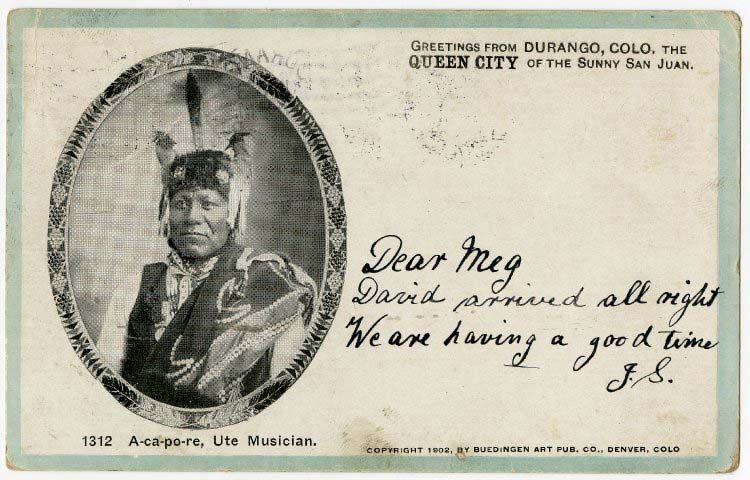 Postcard in British Museum collection "A-ca-po-re, Ute Musician" - published 1902 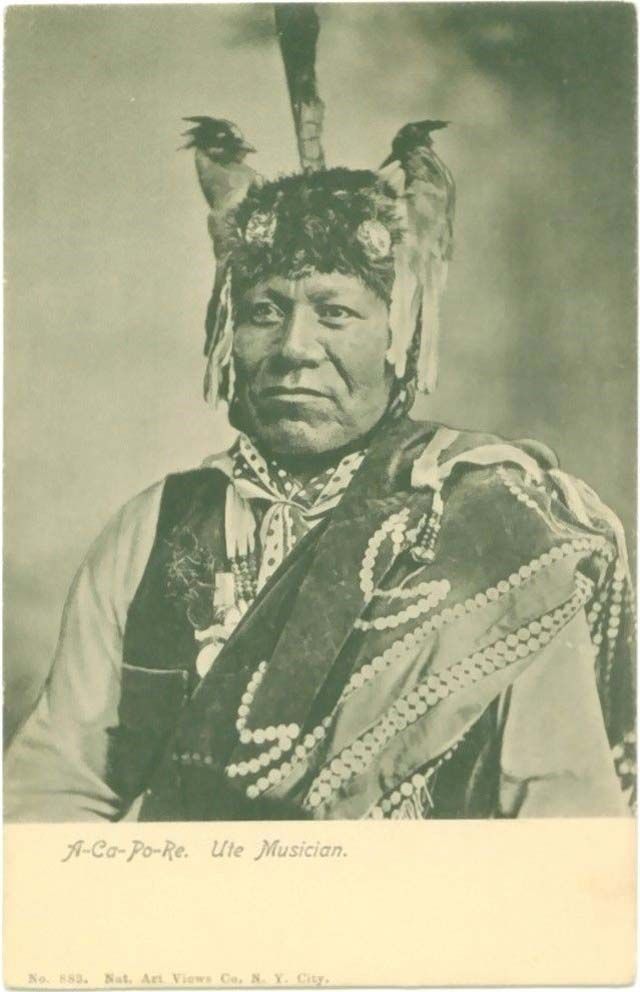 So, A-ca-po-re is rather the individuals name than a twisted Ute band name. |
|